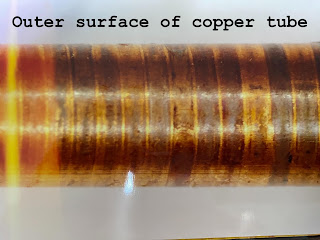วันนี้จะมานำเสนอรูปแบบการเสียหายทางกลพื้นฐาน 10 รูปแบบในฉบับภาษาอังกฤษ แต่ผมจะทยอยลงรายละเอียดที่เป็นภาษาไทยในหัวข้อรูปแบบการเสียหายวัสดุ ซุ่งก็ได้ลงรายละเอียดไปบ้างแล้ว
มีการกล่าวขานกันว่าแรงที่กระทำกับระบบของเราสามารถนำไปสู่ความเสียหายได้หลายรูปแบบ
(Forces imposed on systems can cause failures in many different ways)
Engineers have to take system and environmental forces into account when designing a system or a component , whether the system is a microchip or a skyscraper.
How Understanding Mechanical Failure Modes Improves the Design Process
Components can fail in a variety of different ways based on geometry, load direction, environmental conditions, or other variables. By understanding how something could fail, engineers can design the component to minimize the probability of failure. Designers generally use a factor of safety when designing critical parts. A factor of safety is a multiplier added to design criteria to ensure that not only does the part perform properly under normal loadings, but also performs properly under occasional overloadings
The ten primary modes for failure of mechanical components include:
Buckling - Buckling is the failure of a long, slender column that has been subjected to a compressive, axial load. As the load is applied, the center of the column span bulges outward, and then either cracks or yields, depending on the material properties of the specific component.
Corrosion - Corrosion is the chemical alteration (generally, but not always, oxidation), of a material due to environmental exposure to corrosive elements. For example, iron or steel that is exposed to air can undergo oxidation, forming iron oxide, commonly known as rust. This reddish-brown material has virtually no structural strength, and can reduce the effective material cross section, and therefore strength of a structure.
Creep - Creep is the slow deformation of a solid material over time due to applied loads and often increased temperatures. Creep can result in changes in material properties and part geometries that can cause failures.
Fatigue - Fatigue is a reduction in the ultimate strength of a material due to cyclic loading of a part. Micro-deformations can occur in loads that are larger than the normal working load. Even elastic deformations can result in material changes that can reduce the ultimate strength over a large number of cycles.
Fracture - Fracture begins as a localized microcrack in a part that slowly grows over time, or grows rapidly when exposed to a large overload. Failure occurs when the crack growth becomes critical and the part breaks. Crack growth often begins in areas of high stress concentration, such as corners.
Impact - Impact failure, just as it sounds, is the failure of a part due to impact with or by another object. A baseball shattering a window is an impact failure.
Rupture - Rupture generally occurs in pressure vessels or other containers when the pressure within the vessel exceeds the strength of a vessel, either globally or locally. Overpressure can cause rupture, as well as localized reduction in wall thickness due to corrosion or wear.
Thermal Shock - Thermal shock is the result of a component moving quickly from one temperature extreme to another. For example, brittle materials such as cast iron experience thermal shock if a hot part is suddenly cooled. The part can then crack or shatter because the material does not have the ductility to withstand the sudden thermal contraction of the material.
Wear - Wear is the gradual removal of material by two parts rubbing against each other, or environmental contact with a part, such as water or sand. As material is removed, the effective cross section of a load bearing part is reduced, increasing the stress on the part even though the applied load is constant.
Yielding - Yielding is the stress failure of a part due to overloading. As a load is applied to the component, the stress in the part increases. Based on the stress-strain curve for that particular material, the yield point is essentially the peak load that the part can hold before the material stretches apart.
While every operating environment contains different variables, engineers need to understand the different modes of failure so that they can design their parts with a factor of safety large enough to minimize the probability of failure during normal working operations and during potential overloading conditions.
รายละเอียดเพิ่มเติมสามารถอ่านได้ที่ http://mechanical-engineering.suite101.com/article.cfm/ten_mechanical_failure_modes
สมัครสมาชิก:
ส่งความคิดเห็น (Atom)
การกัดกร่อนกับท่อทองแดงแบบรังมด (Ant-nest corrosion)
วันนี้มีเคสจากหน่วยงานขนส่งมวลแห่งหนึ่งแจ้งว่าท่อทองแดงในระบบเครื่องปรับอากาศเกิดการกัดกร่อนแล้วนำมาสู่การรั่วมาปรึกษา ผมจำได้ว่าเคยวิเคราะห...

-
วันนี้เราเรียนรู้รูปแบบการเสียหายของวัสดุในรูปแบบถัดมา นั่นก็คือ การล้า หรือ Fatigue จะมีรายละเอียดเป็นอย่างไร เชิญติดตามได้เลยครับ คำว่า ...
-
cr : https://doi.org/10.1016/j.ijplas.2023.103601 เมื่อชิ้นส่วนโลหะถูกนำมาใช้งานภายใต้สภาวะอุณหภูมิสูงในขณะเดียวกันก็รับความเค้นแรงดึงไปด้ว...
-
วันนี้ขอนำเสนอรูปแบบการเสียหายของวัสดุแบบที่ 2 คือ การเสียหายแบบเหนียว วัสดุเหนียวที่ถูกใช้งานภายใต้สภาวะการรับความเค้นแรงดึง (Tensile Str...



Metallurgical Failure Analysis: Ten Mechanical Failure Modes >>>>> Download Now
ตอบลบ>>>>> Download Full
Metallurgical Failure Analysis: Ten Mechanical Failure Modes >>>>> Download LINK
>>>>> Download Now
Metallurgical Failure Analysis: Ten Mechanical Failure Modes >>>>> Download Full
>>>>> Download LINK zl